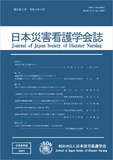Japanese
English
- 有料閲覧
- Abstract 文献概要
- 参考文献 Reference
要約
目的:新潟県内の医療的ケア児の養育者における災害への備えの実態を明らかにすることとした.
方法:新潟県内の三次救急医療施設において,フォローアップを要する医療的ケア児の養育者を対象に,郵送法による無記名自記式調査票にて回答を得た.調査項目は,回答者と子どもの属性,独自に作成した災害への備え全37項目を設定した.分析は各備えの実施率を算出した.
結果:47名を分析対象とした(回収率10.7%).自助の「健康保険証等の持ち出し準備」や「バギー等の移動手段の確保」など計4項目が実施率80%を超える一方で,共助の「避難訓練への参加」や「地域住民との話し合い」は実施率20%未満,公助の「個別避難計画に基づく避難訓練」の実施率は0%であった.
考察・結論:備えには寒冷地ゆえの備えの特徴がみられ,加えて,日常生活に通じる自助に関する備えは実施率が高かった.一方,避難訓練や近隣住民との話し合いなど共助・公助に関する備えは低く,当事者支援のための体制づくりが課題であった.
Abstract
Purpose: This study aimed to elucidate the realities of disaster preparedness among caregivers of children receiving medical care in Niigata Prefecture.
Methods: The study targeted caregivers of children receiving medical care who required follow-up appointments at tertiary emergency care facilities in Niigata Prefecture. Participants' responses to an anonymous self-administered questionnaire were collected by mail. The survey comprised 37 items, including information on respondents' and children's demographics and originally developed items on disaster preparedness. The responses were analyzed by calculating the implementation rate of various forms of disaster preparedness.
Results: A total of 47 responses were analyzed (response rate: 10.7%). In the self-help category, which consisted of four items, including "getting health insurance cards, etc. ready" and "securing a stroller or other means of transportation," the implementation rate was greater than 80%. In contrast, in the mutual aid category, with items such as "participation in disaster drills" and "conversations with community members," the implementation rate was less than 20%. In the public assistance category, which included "disaster drills based on individualized evacuation plans," the implementation rate was 0%.
Discussion and Conclusions: In addition to the distinct forms of preparedness found regarding surviving cold climates, high implementation rates were observed for preparedness related to self-help in everyday life. Conversely, preparedness related to mutual aid and public assistance, including disaster drills and conversations with neighbors, was low. Therefore, establishing systems to support the parties involved remains a challenge.
Copyright © 2023, Japan Society of Disaster Nursing All rights reserved.


